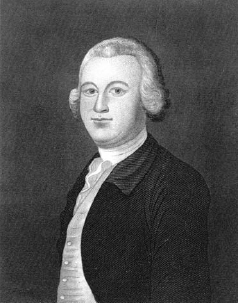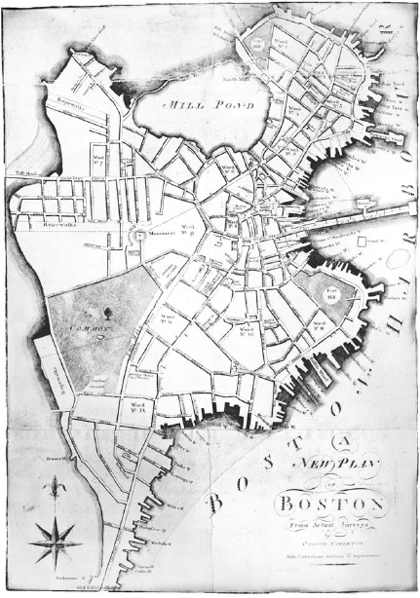American Tempest (3 page)
Authors: Harlow Giles Unger

“I truly can have no property which another can by right take from me when he pleases,” Samuel Adams thundered. “If our trade may be taxed, why not out lands? Why not the produce of our lands and everything we possess or make use of?”
7
Chief Justice Oliver, however, dismissed Adams's complaints, insisting that personal ambitions lay behind the carping of Adams and other organizers of the tax protests.
“Toward the latter end of the year 1760,” Oliver explained, “the chief justice of the province of Massachusetts died, and a mentally unbalanced, but politically ambitious young lawyer, James Otis, Jr., swore
that if
his father was not appointed justice of the superior court [to replace the deceased jurist],
he would do all the mischief he could to the government [and] would set the province in a flame if he died in the attempt
.”
8
Oliver's brother-in-law Thomas Hutchinson, a phenomenally prosperous Boston merchant who later became Massachusetts royal governor, agreed that Otis provided the “spark” that kindled the conflagration that eventually engulfed Boston.
At the time of Otis's outburst, Hutchinson was lieutenant governor of Massachusetts, and the death of the chief justice had interrupted a critical trial with constitutional ramifications. By seniority and years of service in the Massachusetts House of Representatives, Otis's father, Colonel James Otis, Sr., deserved the higher post. Indeed, two former royal governors had promised him the job as a reward for service as militia commander in the war against the French and for twenty-five years of service as judge in Barnstable, Massachusetts. Elected Speaker of the House of Representatives, Otis was both the logical and the most popular choice, but the new royal governor, Sir Francis Bernard, rejected him because of what he said was a
clear conflict of interest: His son, James Otis, Jr., was one of the lawyers representing a group of Salem merchants opposing the crown. Instead, Bernard appointed Hutchinson rather than the elder Otis, and according to Oliver, “the two Otises now exerted themselves,
totis viribus
[with all one's might], to revenge their disappointment in Mr. Hutchinson's destruction.”
9
Bernard's choice of Hutchinson set off a storm of protests. Although a brilliant graduate of Harvard College, Hutchinson was one of Boston's leading merchants and faced no less a conflict of interest in judging a group of Salem merchants than the elder Otis. In addition, Hutchinson was not even a lawyer and had no legal training. Even Hutchinson himself puzzled over Bernard's decision to appoint him, given Bernard's own background in the law. Hutchinson's deficiencies became evident when he took his seat on the bench and faced the brilliant arguments of the younger Otisâa consummate lawyer who attacked with a vengeance. He did not disguise his intent to humiliate the great merchant, who, Otis believed, was more responsible than Bernard for crippling his father's career and, indeed, damaging the older man emotionally.
“Otis was a flame of fire,” according to John Adams. “He demonstrated the illegality, the unconstitutionality, the iniquity and inhumanity” of the crown's case so cogently “that every man appeared to me to go away ready to take arms against it. No harangue of Demosthenes or Cicero ever had such effects.” Adams was a young lawyer then and had come to observe what he and many of his colleagues considered one of the most important cases in colonial history. “American independence,” Adams enthused, “was then and there born; the seeds of patriots and heroes were then and there sown.”
10
At the heart of the case was whether a customs official had the right to issue a blanket search warrant, or “writ of assistance,” and, without warning, “search in all suspected places” for smuggled goodsâon a merchant's ship, in his barns, in any and every room of his home and anywhere on the merchant's property he chose. Otis called writs “against the fundamental principles of law,” arguing that “every man is an independent sovereign. . . . His right to his life, his liberty, no created being could rightfully contest. Nor is his right to property less contestable.”
11

The crown, however, did not dispute man's right to propertyâonly his right to property that he smuggled to America without paying import duties.
The roots of the dispute stretched back three decades to 1733, when Britain passed the Molasses Actâthe first of a series of ill-advised tax laws that would eventually incite Americans to rebellion. The Molasses Act of 1733 added a six-pence-a-gallon duty on foreign molasses, which American distillers claimed would all but destroy their industry, drive many of them into bankruptcy, and put thousands of their employees out of work. It was not the first time Parliament had interfered in American trade, but it was the first time Parliament had enacted a tax that seemed to limit the growth of a colonial industry. The Navigation Act of 1660, for example, had restricted the carrying trade in and out of the American colonies to
British or American ships, but the restriction spurred the growth of an enormous American ship-building industry that not only eclipsed England's shipbuilders but made it the finest such industry in the world. New England's huge, virgin forests yielded seemingly endless supplies of the finest oak for ships' hulls and incomparably strong and flexible white pines for use as masts. Massachusetts shipbuilders built better quality ships at half the price of comparable English ships, and because of the nearness of forests to the sea, they built them in one-third the time. By 1700 Massachusetts shipyards alone were launching 140 ships a year, and by mid-century, American shipyards as a group had built more than 30 percent of all the ships sailing under the British flag.
And because Boston lay in a protected harbor closer to Britain than any other large American seaport, it rapidly became America's richest, most important shipping center. It boasted other advantages as well. For one thing, it lay on the edge of the infinitely rich New England fishing and whaling grounds. For another, its unusual contour allowed far more wharves to be constructed than in a conventional port city lying in a straight line along the water's edge. Eighteenth-century Boston was almost an islandâits only tie to the mainland a narrow little strip of land called Boston Neck, which reached across an expanse of tidal marshes and mud flats that would eventually be filled and renamed Back Bay (see
map 1
,
page 12
). Seen from above, the town lay in the water like a fallen bird, its stubby wings outspread, one of them stretching into the Charles River on the northwest and the other reaching into the harbor pointing the way to the open sea. Its headâthe North Endâlay in the middle of the water, beneath Charles-town. Its multiform shape gave it an enormously long shoreline that permitted construction of endless numbers of wharves and attracted more merchants than conventional ports, along with thousands of waterfront workers from Europe, England, Scotland, Ireland, and elsewhere.
At high tide the Charles River estuary flooded the mud flats and salt marshes to the west of the city and formed the Back Bay. On the east, or harbor side, endless finger piers reached into the water, side by side, embracing hundreds of sailing ships that glided in and out of the harbor each day. After viewing the many ships, the shops, and the opulent mansions of Boston's merchants, Swedish botanist Peter Kalm, who came to America in 1748 on a natural history survey, remarked, “They outdo London.” Later, he lauded the city's “grandeur and perfection. . . . Its fine appearance, good regulations, trade, riches, and power are by no means inferior to those of any, even the most ancient towns of Europe.”
12

Unlike Britain, where class barriers frustrated the ambitions of those seeking wealth, the colonies offered unimagined wealth to almost any talented, imaginative, hard-working man, regardless of social or economic classâprovided, of course, he fit into community racial and religious norms. Many of Boston's wealthiest merchants began in small, specialized shopsâbooks, in the case of Thomas Hancock. Books were a good choice in a colony that, from its beginnings, made education and the teaching of literacy compulsory and created a population that depended on reading as a major leisure activity. Besides the Scriptures, every bookseller carried tracts and sermons of every minister of noteâsold in clumsy, uncut, unbound sheets. Recognizing the need for bookbinding facilities in Boston's growing printing and publishing industry, Thomas Hancock learned bookbinding, became a master bookbinder, and solicited bookbinding orders from Boston's printers and booksellers, who were elated to turn the jumble of unprinted sheets into rows of neatly shelved, easy-to-find, bound books. Hancock accepted payment in stocks of stationery and printed materials as well as cash. By the end of six months, he had accumulated enough to expand his shop to include stationeryâwriting paper, quills, sealing wax, inkhornsâeven spectaclesâalong with an enormous array of books: “Bibles large and small, Testaments, Psalters, Psalm Books with tunes or without, Singing-books, School-books . . . Books on Divinity, Philosophy, History, Navigation, Physics, Mathematics, Poetry. . . .”
Only one constraint slowed Boston merchants' breathtaking race to riches: a shortage of cash. Most New Englanders did business by barter, with some trading their labor or handiwork for food, lodging, and other necessities. Others hunted, fished and farmed to survive. Merchants routinely accepted produce, livestock, pelts, whiskey, and other goods as currency. Although many small merchants fell by the economic wayside, bolderâand luckierâmerchants gambled every penny they had on growth, expanding into general stores with a wide variety of cloth (calico, chintz, muslin, cotton, buckram, taffetas, damasks, and silks), thread, fans,
girdles, “and sundry other sorts of Haberdashery,” according to an advertisement in the
Boston News-Letter
. The ad also listed “Silk Shoes, Men's and Women's Hose, millinery, compasses, hour glasses, leather, cutlery, and such staples as sugar, tea and corn.”
13
The most successful merchants organized their stores into departments; some offered volume discounts, and all tried stocking their shelves according to seasonal needs, selling off one season's goods before the new season began, to avoid accumulating shopworn inventories. Their advertisements were clever for that era:
Excellent Bohea Tea, imported in the last ship from London:
sold by Tho. Hancock.
N.B. If it don't suit the ladies' taste, they may return the tea and receive their money again.
14
The women's dress department was usually the largest, with cloth, ribbons, knee and shoe buckles, hats, fans, and other items. Hardware departments, with brass compasses, fire steels, larding pins, swords, and so forth, provided about 10 percent of total sales. Rum and similar provisions also contributed about 10 percent of sales, whereas coal and ships' stores accounted for just over 1 percent in the early eighteenth century and tea somewhat less than 1 percent. Americans had yet to discover the pleasures and pomp of tea and tea parties.
Few shoppers could not find what they needed at the House of Hancock, the House of Hutchinson, or the other great merchant houses. Flocks of city and country folk filled Boston's general stores store each day, and as sales increased, some merchants bought larger quantities at lower costs and expanded into wholesaling, supplying shopkeepers, farms, and merchants in smaller towns. The largest housesâlike the House of Hutchinson and House of Hancockâalso supplied the government and the military, which forced them to extend credit and drew them into banking.
